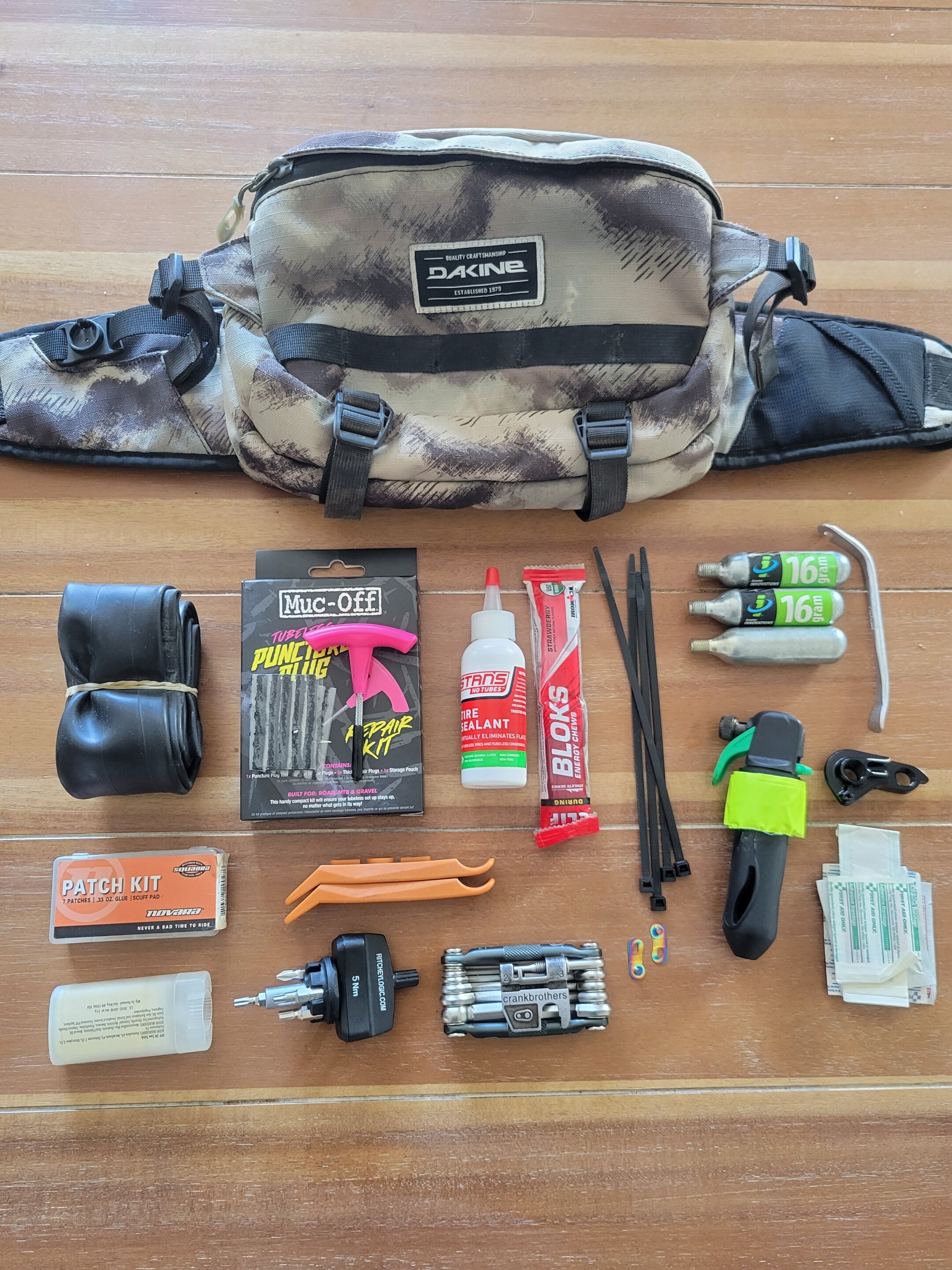Have you ever started a ride and wondered if you were adequately prepared for unforeseeable issues? Have you been in a situation where you did not have the tools necessary to fix a mechanical on the trail that resulted in a hike-a-bike back to your car? Have you realized at the top of a sunny peak that you don’t have enough water, fuel, or sunscreen? We’ve all been there. Unfortunately, issues that could be a minor trailside fix can easily turn into a ruined adventure if you’re not properly equipped.
What you carry will depend on your riding style, how far you're going, the terrain you are traveling, and whether you’re riding alone or with a partner. We’ve compiled a list of commonly carried mountain-biking adventure items below. We will refer to carrying items in your pack, which could mean a classic backpack, a hip pack, seat/saddle bag, a frame or handlebar bag, or essentials attached directly to your frame or inside frame compartments.
Essential Tools To Carry On a Bike Ride
Multi-Tool
A multi-tool is an essential item that every rider should carry for needed adjustments on the trail. We recommend a multi-tool with a chain break tool included. Check out more multi-tool options here.
Torque Key
A torque key (also called a torque wrench) is used to tighten most bolts on your bike to a specific torque in order to avoid bike damage resulting from over-tightening. Some keys have adjustable torques that allow more versatility; however, keys with preset torques are lighter and sufficient to raise your seat or tighten your handlebars.
Flat-Repair Supplies
Most mountain-bike riders will experience a flat tire (or dozens). Fortunately, trail-side flat repair is easier than ever!
CO2 or Pump
It’s crucial to carry an inflating device for potential flats, tire punctures, and/or pressure adjustments. CO2 inflators are more compact than hand pumps, but supply a limited quantity of air and are less environmentally friendly. Hand pumps are unlimited in air supply, but bulkier. Many include pressure gauges for added convenience. Consider purchasing a more expensive hand pump, you won’t be disappointed when the time comes to use it!
CO2 Cartridges
If you opt to carry CO2 inflators, don’t forget CO2 cartridges and refills. Keep in mind that airlines do not allow cartridges on board, so if you are traveling with your bike you will need to find CO2 cartridge refills once you arrive at your destination.
Tire-Plug Repair Kits
Riders running tubeless tires (and we hope you are) often carry tire plug kits—also known as bacon strips. Tire sealant is usually sufficient to protect against small holes caused by glass shards or thorns, but tire plugs can be used to seal larger punctures. Tire plugs are easier to use than the patch-kit and tire-changing methods! Thank you, tubeless-tire technology! Keep in mind that you may need to use more than one plug per puncture, and some holes are too large for plugs.
Stans DART Tool
Instead of tire-plug kits, some riders carry Stans DART Tool. The tool inserts a barbed tip and flexible material that forms an airtight seal in the puncture by bonding with latex sealants. It is simple to use and easy to refill. Importantly, the DART tool is not recommended for punctures smaller than 5mm.
Extra Sealant
Consider carrying a small bottle of tire sealant to fix minor flats and replenish sealant lost through punctures.
Extra Tubes
With tubeless tires, tire plugs, and tire inserts like Cushcore becoming increasingly popular, you may be tempted to leave extra tubes at home; however, many riders still carry tubes as back up—especially for longer rides. Make sure you select the right size for your wheels (29 or 27.5).
Tire Levers
Tire levers are inexpensive and lightweight tools that help remove tires from rims. Most riders carry two or three tire levers. Aluminum or metal levers are useful for more stubborn tires (often downhill bikes); however, use caution—metal levers can cause damage if used with too much force.
What to Carry on a Bike Ride (Not Including Flat Repair Tools)
Master Links
Bring spare chain links and a chain tool in case your chain breaks. Chain links are specific to your chain brand and model. Chain links are small and easy to carry!!
First-Aid Kit
A basic first-aid kit can help treat abrasions, bites, and pain associated with your skin meeting the soil (or rocks or trees… you get the picture). Good components include Benadryl, Aspirin, antiseptic swabs, bandaids, first-aid tape, non stick pads and gauze. Other compact first aid kits can be found here and here.
Duct Tape, Zip Ties, or Straps
Broken bottle cage? Torn backpack? Detached shoe sole? Cracked helmet? If you spend time in the backcountry, you will inevitably eventually need to attach something to… another thing. The possible scenarios are limitless, but trust us—you will eventually be grateful you’re carrying strong tape, zip ties, or our favorite: polyurethane straps. Consider wrapping some duct tape around your hand pump and/or carry various sizes of zip ties or straps. (And pssst… replace your broken helmet when you get home!)
Spare Derailleur hanger
Derailleur hangers are designed to break or bend in order to protect your derailleur, and replacing them is relatively simple. Carrying a spare derailleur hanger can save you a lot of hassle on the trail. As with master chain links, hangers are specific for your bike’s make and model.
Spare Nuts and Bolts
Whether at home or on the trail, nuts and bolts are easy to lose. Fortunately, they are small and easy to stash. Pick up some extras for your pack--they will be easier to keep track of if you put them in a small zipper bag.
Hydration and Fuel
In the mountains, you should always expect the unexpected. Injuries, weather conditions, bike problems, and trail conditions can keep you out much longer than you expected. Even when conditions are ideal, you or another rider could bonk or become dehydrated unexpectedly. Always carry adequate fuel and water. We personally love carrying shot blocks,
Pepper spray or Bear Spray
Pepper spray is a popular form of self protection against humans or animals, particularly for solo rides. Some pepper spray comes in compact canisters that can be velcroed to your handlebars or frame. If you are planning a ride through bear country, we highly recommend carrying bear spray and having it easily accessible. Bikers can easily spook bears, as bikers travel at faster speeds and make less noise than hikers. When possible, ride in groups, make noise as you ride, and/or carry a bear bell.
Map or Mobile Trail Apps
Bring a map or download a smartphone app that can help you keep you on course or find alternative routes if needed. Popular apps include Trailforks, Gaia, and AllTrails, which can be accessed without cell-phone coverage or in airplane mode (some apps require map downloads prior to using their maps offline).
Charged Cell Phone
Smartphone apps won’t do you any good if you run out of battery power! Begin your rides with a fully charged cell-phone. If you know you are traveling in areas with poor cell-phone coverage, switch to airplane mode to save power. Many riders bring portable power banks.
Extra Layers
Check the weather and be prepared for changing conditions. Most riders carry a compact wind/rain jacket in their packs. Both the Patagonia Houdini and the Patagonia Dirt Roamer Jacket are lightweight and packable. An emergency poncho is also a great option.
Emergency Supplies
If you’re riding far from the madding crowd, consider bringing an emergency blanket, waterproof matches, and a lightweight, water-filtering straw or Iodine Tablets for an unexpected night in the woods.
What to Carry on Longer Rides
For longer rides or longer backcountry bike tours you may want to consider carrying these items in addition to the items listed above:
The contents of a mountain-biking pack will vary among riders and routes, and mountain bikers must strike a balance between being ultra prepared and becoming weighed down with too much gear. When choosing what to carry, take into consideration your range of bike-maintenance skills but also remember that your partners or even strangers are usually willing to help out a fellow dirt traveller in distress. If you’re new to mountain biking, prioritize learning how to fix flats and tire punctures, as well as how to use mountain-bike tools to make basic adjustments and repairs. This will leave you more prepared and confident when riding out on the trails. As you gain more experience, you can add other tools to better equip yourself for handling issues on the trails.
The Mountain Bike Mastery Course is where we take your mountain bike skills to the next level and way beyond. Join from anywhere in the world for the most in-depth, personalized coaching possible. Make some magic on your bike with Coach Erica Tingey supporting you every pedal stroke of the way.

